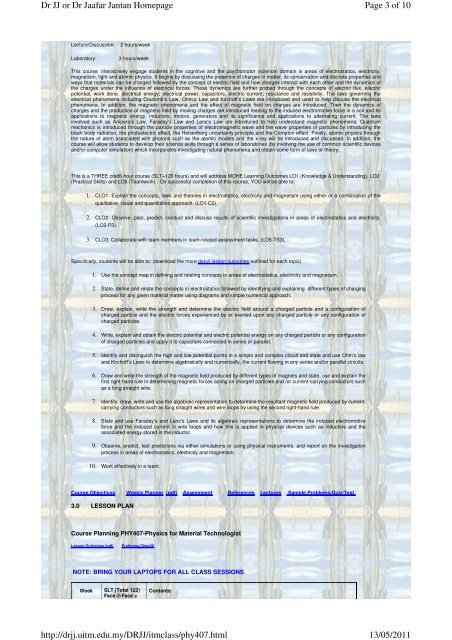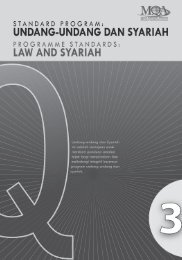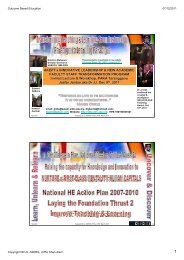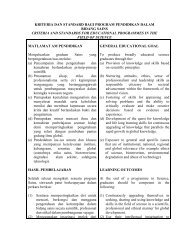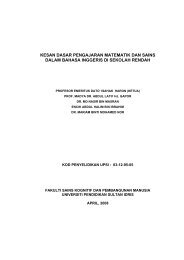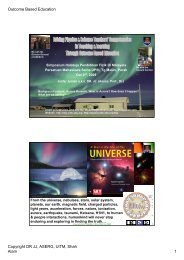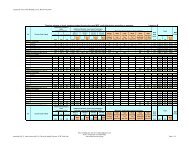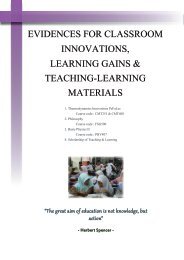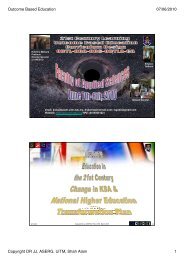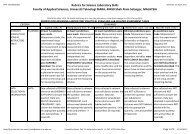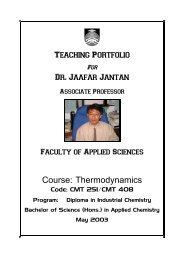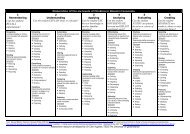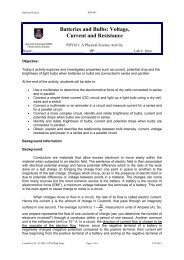Basic Physics II Evidences - DrJJ - UiTM
Basic Physics II Evidences - DrJJ - UiTM
Basic Physics II Evidences - DrJJ - UiTM
Create successful ePaper yourself
Turn your PDF publications into a flip-book with our unique Google optimized e-Paper software.
Dr JJ or Dr Jaafar Jantan Homepagehttp://drjj.uitm.edu.my/DRJJ/itmclass/phy407.htmlPage 3 of 1013/05/2011Lecture/Discussion: 2 hours/weekLaboratory:3 hours/weekThis course interactively engage students in the cognitive and the psychomotor (science) domain in areas of electrostatics, electricity,magnetism, light and atomic physics. It begins by discussing the presence of charges in matter, its conservation and discrete properties andways that materials can be charged followed by the concept of electric field and how charges interact with each other and the dynamics ofthe charges under the influence of electrical forces. These dynamics are further probed through the concepts of electric flux, electricpotential, work done, electrical energy, electrical power, capacitors, electric current, resistance and resistivity. The laws governing theelectrical phenomena including Coulomb’s Law, Ohm;s Law and Kirchoff’s Laws are introduced and used to help discuss the electricalphenomena. In addition, the magnetic phenomena and the effect of magnetic field on charges are introduced. Then the dynamics ofcharges and the production of magnetic field by moving charges are introduced leading to the induced electromotive force in a coil and itsapplications to magnetic energy, inductors, motors, generators and its significance and applications to alternating current. The lawsinvolved such as Ampere’s Law, Faraday’s Law and Lenz’s Law are introduced to help understand magnetic phenomena. Quantummechanics is introduced through the particle properties of electromagnetic wave and the wave properties of particles by introducing theblack body radiation, the photoelectric effect, the Heisenberg uncertainty principle and the Compton effect. Finally, atomic physics throughthe nature of atom associated with photons such as the atomic models and the x-ray will be introduced and discussed. In addition, thecourse will allow students to develop their science skills through a series of laboratories (by involving the use of common scientific devicesand/or computer simulation) which incorporates investigating natural phenomena and obtain some form of laws or theory.This is a THREE credit-hour course (SLT=120 hours) and will address MOHE Learning Outcomes LO1 (Knowledge & Understanding), LO2(Practical Skills) and LO5 (Teamwork) . On successful completion of this course, YOU will be able to:1. CLO1: Explain the concepts, laws and theories in electrostatics, electricity and magnetism using either or a combination of thequalitative, visual and quantitative approach. (LO1-C2).2. CLO2: Observe, plan, predict, conduct and discuss results of scientific investigations in areas of electrostatics and electricity.(LO2-P3).3. CLO3: Collaborate with team members in team-related assessment tasks. (LO5-TS3).Specifically, students will be able to: (download the more detail lesson outcomes outlined for each topic)1. Use the concept map in defining and relating concepts in areas of electrostatics, electricity and magnetism.2. State, define and relate the concepts in electrostatics followed by identifying and explaining different types of chargingprocess for any given material matter using diagrams and simple numerical approach.3. Draw, explain, write the strength and determine the electric field around a charged particle and a configuration ofcharged particle and the electric forces experienced by or exerted upon any charged particle or any configuration ofcharged particles.4. Write, explain and obtain the electric potential and electric potential energy on any charged particle or any configurationof charged particles and apply it to capacitors connected in series or parallel.5. Identify and distinguish the high and low potential points in a simple and complex circuit and state and use Ohm’s lawand Kirchoff’s Laws to determine algebraically and numerically, the current flowing in any series and/or parallel circuits.6. Draw and write the strength of the magnetic field produced by different types of magnets and state, use and explain thefirst right hand rule in determining magnetic forces acting on charged particles and /or current-carrying conductors suchas a long straight wire.7. Identify, draw, write and use the algebraic representation to determine the resultant magnetic field produced by currentcarryingconductors such as long straight wires and wire loops by using the second right-hand rule.8. State and use Faraday’s and Lenz’s Laws and its algebraic representations to determine the induced electromotiveforce and the induced current in wire loops and how this is applied in physical devices such as inductors and theassociated energy stored in the inductor.9. Observe, predict, test predictions via either simulations or using physical instruments, and report on the investigationprocess in areas of electrostatics, electricity and magnetism.10. Work effectively in a team.Course Objectives Weekly Planner (pdf) Assessment References Lectures Sample Problems/Quiz/Test3.0 LESSON PLANCourse Planning PHY407-<strong>Physics</strong> for Material TechnologistLesson Outcomes (pdf)Problems-Chap20NOTE: BRING YOUR LAPTOPS FOR ALL CLASS SESSIONSWeek SLT (Total 122)Face-2-Face +Contents


